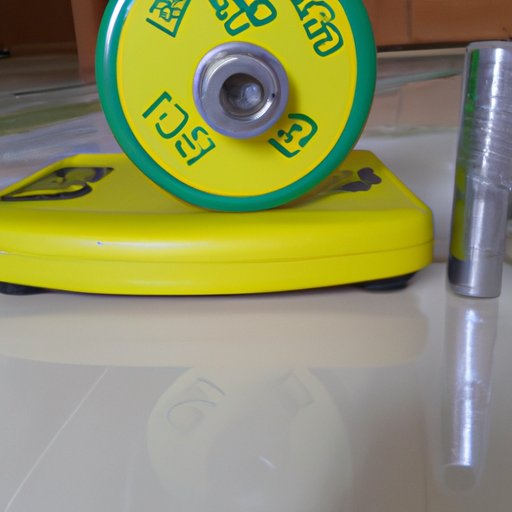Introduction
Cholesterol is an essential part of a healthy body, but too much of it can cause serious health problems. High cholesterol can lead to heart disease, stroke, and other serious conditions. Fortunately, there are things that people can do to help manage their cholesterol levels and reduce their risk for developing these conditions. One of the most effective ways to control cholesterol is through regular exercise.

Analyzing the Benefits of Exercise on Cholesterol Levels
Exercise has many benefits for overall health, but one of the key ways it can help is by balancing out cholesterol levels. The American Heart Association (AHA) recommends exercising for at least 30 minutes five days a week to help keep cholesterol in check. Regular exercise can help raise the level of HDL (good) cholesterol while lowering the level of LDL (bad) cholesterol.
There are different types of exercises that can help lower cholesterol. Cardio activities such as running, swimming, and cycling are especially beneficial for managing cholesterol. Strength training can also be beneficial, as it helps build muscle mass which can help reduce the amount of LDL cholesterol in the body.

Examining the Impact of Regular Exercise on Cholesterol Levels
In order to see results from exercise, it must be done on a regular basis and with enough intensity to make a difference. The AHA recommends at least 30 minutes of moderate to vigorous activity five times a week in order to see a significant impact on cholesterol levels. Doing more intense activities such as HIIT or interval training can also help to further lower cholesterol.
The effects of regular exercise on cholesterol levels can vary depending on the individual. Generally, people who exercise regularly can expect to see a decrease in overall cholesterol levels and an increase in HDL cholesterol. This can help reduce the risk of developing heart disease or having a stroke.
Exploring the Relationship Between Exercise and Lower Cholesterol
It’s important to remember that genetics can play a role in determining cholesterol levels. Some people may need to exercise more frequently or more intensely than others in order to see a change in their cholesterol levels. It’s also important to note that diet plays a role in managing cholesterol levels. Eating a balanced diet low in saturated fat and cholesterol will help to keep cholesterol levels in check.
Exercise and diet go hand-in-hand when it comes to managing cholesterol levels. Both should be incorporated into a healthy lifestyle in order to achieve optimal results. Eating a healthy diet and exercising regularly can help to reduce LDL cholesterol and increase HDL cholesterol, which can help reduce the risk of developing heart disease.

How Exercise Can Help Reduce High Cholesterol Levels
Cardio exercises are the best type of exercise for reducing cholesterol levels. Activities such as running, swimming, and cycling can help to raise HDL cholesterol and lower LDL cholesterol. This can help reduce the risk of developing heart disease or having a stroke. Strength training can also be beneficial, as it helps build muscle mass which can help reduce the amount of LDL cholesterol in the body.
Other forms of exercise such as yoga, Pilates, and Tai Chi can also help to lower cholesterol. These activities can help to reduce stress, which can have a positive effect on cholesterol levels. All types of exercise can help to improve overall health and wellbeing.
Investigating the Link Between Exercise and Cholesterol Management
It’s important to remember that in order to see long-term results, regular exercise must be done. People who exercise regularly can expect to see a decrease in overall cholesterol levels and an increase in HDL cholesterol. Regular exercise can also help to reduce the risk of developing heart disease or having a stroke.
It’s also important to monitor cholesterol levels in order to determine if exercise is having an effect. Blood tests can be used to measure cholesterol levels and determine if any changes need to be made to diet or exercise habits.
Comparing the Effects of Exercise and Diet on Cholesterol Levels
Both exercise and diet play a role in managing cholesterol levels. Eating a healthy diet low in saturated fat and cholesterol can help to reduce LDL cholesterol. Exercise can help to raise HDL cholesterol and lower LDL cholesterol. The best combination for managing cholesterol levels is to incorporate both healthy eating and regular exercise into a daily routine.
Conclusion
Exercise is an important part of maintaining good health, and it can also help to manage cholesterol levels. Regular exercise can help to raise HDL cholesterol and lower LDL cholesterol, which can reduce the risk of developing heart disease or having a stroke. It’s important to remember that diet also plays a role in managing cholesterol levels, so it’s best to combine a healthy diet with regular exercise for optimal results.
In conclusion, exercising regularly can help to lower cholesterol levels and reduce the risk of developing heart disease. Incorporating both diet and exercise into a daily routine is the best way to maintain healthy cholesterol levels and enjoy a healthier lifestyle.
(Note: Is this article not meeting your expectations? Do you have knowledge or insights to share? Unlock new opportunities and expand your reach by joining our authors team. Click Registration to join us and share your expertise with our readers.)
